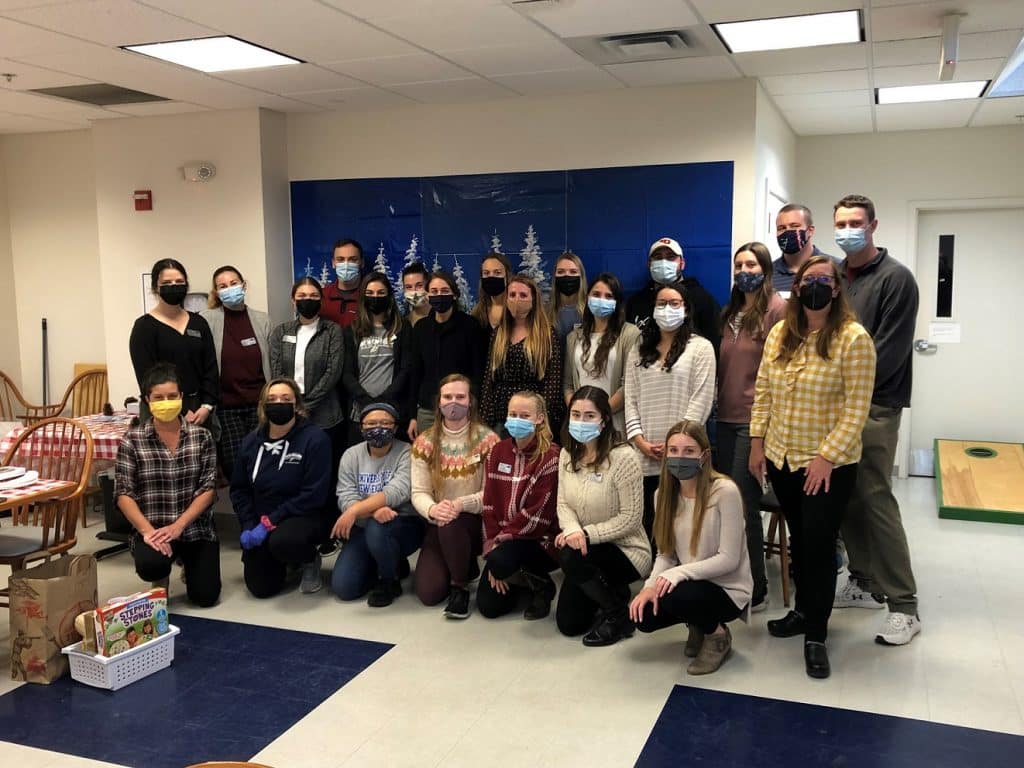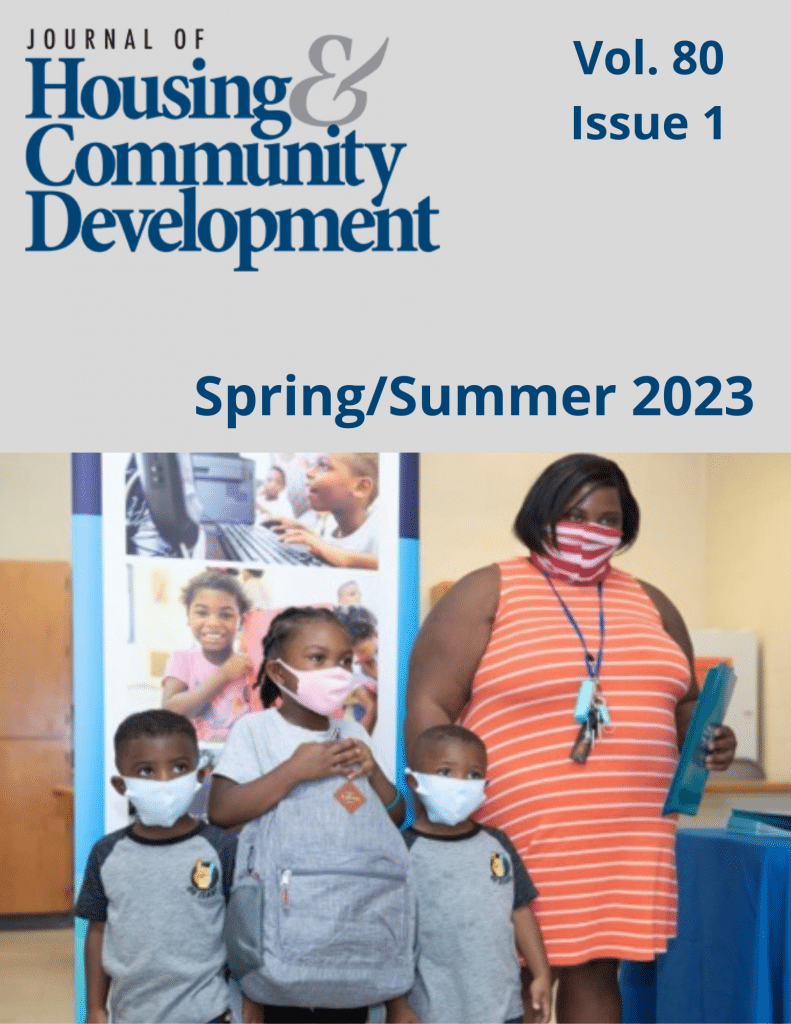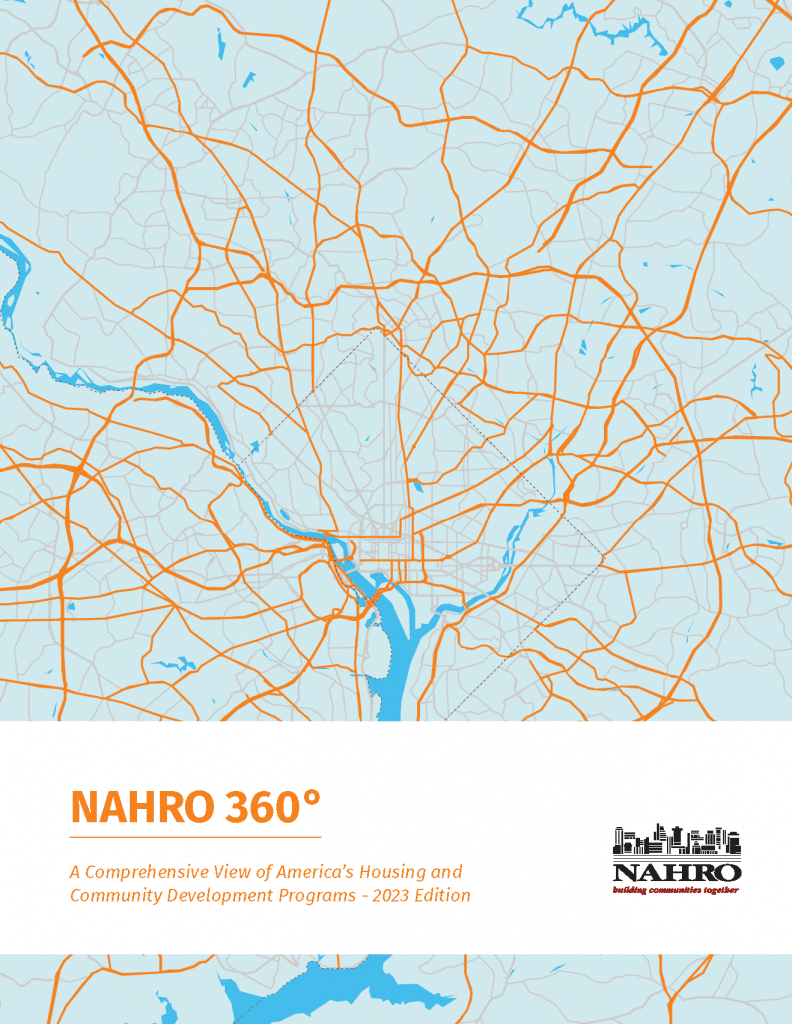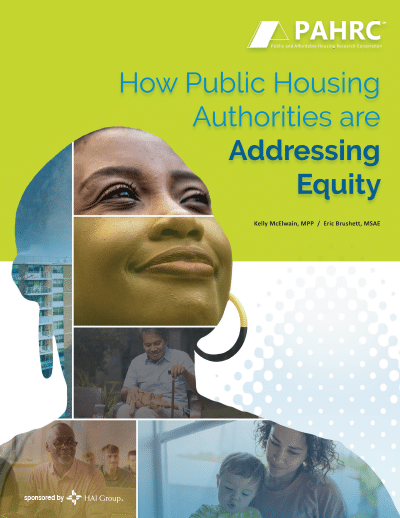2022 Award of Excellence Winners
In March 2023, the National Association of Housing and Redevelopment Officials (NAHRO) awarded 20 prestigious Awards of Excellence to 16 housing and community development organizations. The awards were presented during the 2023 Washington Conference, NAHRO at 90: ADVOCATE in Washington, D.C.
Selected by regional juries from an initial pool of 178 Awards of Merit recipients, each of the winning programs improves resident outcomes, resolves problems, is replicable by similarly-sized organizations, and produces tangible results.
The winning programs are:
Administrative Innovation

HACLA University • Housing Authority of the City of Los Angeles (HACLA)
Designed as an in-house training program, “HACLA University” was spearheaded by the Legal Department, offering comprehensive, interactive courses in subjects ranging from local landlord-tenant law and HUD policies to HACLA branding and professional writing style. The monthly virtual seminars were open to all HACLA staff, and topics were sourced from across the agency.
HACLA is one of the nation’s largest housing authorities, providing housing or housing assistance to over 69,000 Los Angeles households. Despite an annual budget of over $1 billion, the need for affordable housing in Los Angeles remains critical. HACLA leadership are therefore focused on directing as much of their funding toward housing as possible, and no additional funds or outside resources were used to develop or administer HACLA University. Instead, HACLA staff pulled from their own knowledge and expertise to educate their peers, simultaneously advancing their own professional development as public speakers.

Self-Service Kiosks • Cuyahoga Metropolitan Housing Authority (CMHA)
CMHA’s project to install self-service customer kiosks kicked off in October 2020 to meet the increased demand of residents while maintaining social distancing during the height of the COVID-19 pandemic. CMHA had long been exploring opportunities to streamline the customer service experience in their main lobby, while providing personalized service to over 10,000 households, and allocated approximately $109,000 to the initiative.
Combining an accessible-height monitor, camera, mouse, keyboard, digital signature pad, scanner, and printer, CMHA’s six kiosks quickly became a one-stop solution for clients managing their waiting list applications, annual recertifications and more. With kiosk service in both English and Spanish, CMHA dramatically improved their capacity to see clients, both during a time of need and into the future.
Double Winner Feature: Oakland Housing Authority
Congratulations to the Oakland Housing Authority (OHA), winning two 2022 NAHRO Awards of Excellence!
Their winning project in Administrative Innovation, a Personal Protective Equipment (PPE) distribution initiative, was designed and executed by their Family and Community Partnerships (FCP) Department immediately following the onset of the COVID-19 pandemic.

In six short weeks, OHA not only developed and issued a survey to their residents by email, text, and phone, but also analyzed 765 responses, developed, and launched a data-informed support strategy.
OHA’s first PPE distribution effort began in May 2020. Leveraging their bulk supplier relationships, which did not face the unprecedented demand that plagued traditional home-use retailers, OHA was able to secure items high-demand items such as toilet paper, a sanitizing cleaner, paper towels, trash bags, toilet cleaner, dish soap, masks, hand soap, and hand sanitizer quickly. On-demand, mix-and-match style kits were distributed to approximately 260 public housing households during this first phase, with most residents visiting the OHA offices to select what they needed and speaking with FCP staff individually about available support services.
While the initial effort was successful and met an urgent need, OHA quickly realized the custom kit was not only administratively burdensome but also required input and multi-stage coordination from already-strained residents and staff.
So, the distribution program shifted to its current model: a standardized bag with 10 essential items, assembled in bulk and distributed at set intervals. Pick-up events were scheduled weekly at two of OHA’s largest public housing sites, serving approximately 9.3 families per staff hour. Following a brief residency verification, residents received a supply bag, learned more about COVID-19 prevention, accessed community resources, and were connected to OHA support services in one (outdoor) visit.
Residents with limited English proficiency were served by a dedicated team, and residents with disabilities (or other travel restrictions) were visited at home by FCP staff. These staff traveled to 240 scattered sites and knocked on almost 1,400 doors to deliver supply kits and conduct wellness checks.
Over the course of the initiative, the regular face-to-face engagement with residents during PPE distribution additionally resulted in an unexpected bump in OHA’s Family Self-Sufficiency (FSS) and Resident Opportunities and Self-Sufficiency (ROSS) Programs. Furthermore, residents who received supplies were more likely to engage in other FCP services across the spectrum and were more likely to develop positive relationships with property management. In short, a small gesture established a much-needed personal connection between residents and OHA staff.
Financially, OHA spent over $86,000 on PPE during the peak of the COVID-19 pandemic, distributing over 1,400 standardized kits to residents of public housing and scattered site properties (by early 2022). Supply purchases were projected to last through 2022. 84% of the initiative was funded through the CARES Act, with the remainder covered by donations to the Oakland Housing Authority Foundation.
With the success of the PPE initiative, OHA plans to continue distributing supplies to new residents at move in, offering families not only a warm welcome, but an opportunity to meet face-to-face with staff and their Resident Advisory Board.

OHA was also awarded in the Resident & Client Services category. Their Seniors Connect Art Kit Program, launched in October 2020, was originally designed as a stop-gap measure to support seniors emotional, mental, and physical health while regular on-site programming was on hold during the COVID-19 pandemic. However, with the program’s success, it too is being integrated into OHA’s typical resident service offerings, along with the many spin-off programs inspired by senior resident feedback.
Loneliness in older adults, especially those who live alone, is not a new phenomenon, but one that was heavily exacerbated in 2020 and 2021. While OHA never stopped performing regular wellness checks on senior residents (by-phone and in person, along with the aforementioned PPE initiative), the delivery visits were fleeting compared to the rich on-site senior programs residents used to enjoy.
The Seniors Connect Art Kit Program took a 3-pronged approach to combatting loneliness: first, the monthly themed art kits (including all necessary supplies) provided resident with a much-needed outlet for their creativity and emotional energy; second, the Senior Connect newsletter, including timely information on OHA services and local guidance; and third a monthly Seniors Connect Zoom meeting, where program participants could socialize and share their creative work.
Starting with 90 seniors, the program doubled in a year, with most participants expressing reduced stress, improved optimism, and renewed spirit. Art kit themes spanned across holidays, cultures, and artistic mediums — mosaics for St. Patrick’s Day, decorative gardening kits for Spring, puzzles, canvas, and paints for every day — encouraging resident to learn new skills, revisit past hobbies and express themselves. Furthermore, the kit delivery and Zoom meetings provided OHA additional opportunities for wellness checks and expanded the reach of resident service providers.
As OHA reinstated in-person programming, seniors who participated in the Art Kit Program became a driving force in revitalizing OHA’s pre-pandemic programming (including meals, socials, fitness, health, cooking, volunteering, and field trips) and identified new resident needs such as digital education and utility carts for groceries. All told, enrollment and expansion ranged from 2 to 5-fold.
The Senior Art Kit Program cost approximately $52,000, over half of which was OHA staff labor. Supply costs were covered by two grant awards from the Bridge Association of Realtors Community Foundation as well as OHA’s MTW funding. OHA plans to continue offering these services through similar funding streams.
Affordable Housing

Vista Verde • National Community Renaissance (NCR)
Vista Verde in Ontario, California, is one of the first all-electric, zero-net energy communities in the region. The 101-unit affordable housing development was constructed from 2019 to 2021, building on over six years of planning and community outreach. From start to finish, the innovative and environmentally conscious $37 million project was community driven, and explored new ways to create a community that is environmentally conscious and reduces its carbon footprint, while also encouraging increased use of public transit to lower transportation-related emissions in the neighborhood and larger region.
Just east of Los Angeles, the city of Ontario sits within the “Inland Empire”. Covering more than 27,000 square miles, the area is one of the fastest growing nationwide. The historic downtown, a primarily Hispanic community, is a Qualified Opportunity Zone, and bears a disproportionately high environmental health burden according to CalEnviroScreen. The UCLA Luskin Center for Innovation’s Ontario Together 2021 Progress Report estimates that Vista Verde will help reduce greenhouse gas emissions in the area by 6,238 metric tons of carbon dioxide equivalents (MTCO₂e), reduce vehicle miles traveled by 16,438,915 miles, and result in travel cost savings of $3,837,640.

Accessory Dwelling Unit Development Pilot Program • San Diego Housing Commission (SDHC)
In 2019, the San Diego Housing Commission began a project to help homeowners in the City of San Diego understand the process of constructing Accessory Dwelling Units (ADUs). Stemming from a 2017 SDHC report “Addressing the Housing Affordability Crisis: San Diego Housing Production Objectives 2018 – 2028,” which identified ADUs as one of the five main sources of potential additional housing units in the City over 10 years, The resulting pilot program, which ran through 2021, built and rented out five ADUs in the available yard space of five SDHC-owned single-family homes at a cost of $1.4 million. These ADUs are currently rented by SDHC tenants and will remain affordable for 55 years for San Diegans with income of up to 80% AMI.
SDHC additionally documented the costs, processes and timelines associated with predevelopment, permitting, and constructing each ADU type, and highlighted lessons learned and key takeaways for San Diego homeowners interested in building ADUs in a comprehensive report. Combined with updates to the San Diego Municipal Code that reduced parking requirements, zoning setbacks and fire sprinklers, and waived Development Impact Fees, Facility Benefit Assessment Fees and General Plan Maintenance Fees, SDHC is confident that the success of this program will contribute to the State of California’s and the City of San Diego’s efforts to facilitate and encouraged the production of ADUs as a strategy to address the shortage of affordable housing.

The Commons on MLK • Homes for Good
The Commons on MLK — a 51-unit permanent supportive housing community — is Lane County’s (Oregon) first permanent supportive housing community that utilizes the Housing First model to house chronically homeless individuals who are the most frequent users of emergency services. The $13 million development, which opened in early 2021, was designed with trauma-informed residents in mind, featuring calming colors, ample natural light, and a balance between privacy and openness. Homes for Good offers a robust range of free and voluntary supportive services, and the community is located next to both Lane County Behavioral Health and the Community Health Centers of Lane County.
The rate of homelessness in Oregon has been on the rise for some time – increasing by 14% between 2014 and 2022. A 2019 analysis of federal data found that Eugene, Oregon (located in Lane County) leads the nation in the number of people experiencing homelessness per capita, ahead of both Los Angeles and New York City. Residents of The Commons on MLK are selected based on participation of the FUSE Program, or Frequent Users System Engagement Program, unit occupancy is 1-2 persons, income limits are at or below 50% AMI, and rent is calculated at 30% of a household’s adjusted gross income. All utilities are included.

Adaptive Reuse serving Homeless Veterans • Yakima Housing Authority (YHA)
Following the City of Yakima (Washington)’s 2016 Homeless Point-in-Time count — where eighty-five homeless veterans, and evidence alluding to approximately 250 in total were identified — the Yakima Housing Authority began earnestly exploring options to house homeless veterans and ensure they had convenient access to services. The resulting development, Chuck Austin Place, opened in 2021. Located on a former Marine Army Base site, the 4.5-acre campus, with forty-one apartments and 12,000 square feet of service space, is named for a beloved Yakima WWII, Korea, and Vietnam war veteran.
While the total development cost was $16 million, the development bears no long-term debt. The site was being dispositioned and was offered to YHA by the U.S. Department of Health and Human Services specifically for this development. Capital costs were funded through the state of Washington (LIHTC, Housing Trust Fund, Direct Appropriations, and Solar Tax Credits), the city of Yakima (HOME), and a local energy provider. Daily operations are offset with VASH and Project-Based Voucher funding.
Community Revitalization
Small Business Emergency Relief Program • Los Angeles County Development Authority (LACDA)
With the onset of the COVID-19 pandemic, Los Angeles County’s small business community immediately faced severe, negative impacts.

LACDA reacted quickly, and within 6 weeks, reallocated staff to develop the Small Business Emergency Relief Program. Instead of a single-program model, LACDA designed multiple funding strategies, engaging various sources, to provide over $102 million in grants and loans to 6,320 businesses, including childcare providers, restaurants, and retail shops. $6 million were utilized towards operating costs. Funding was primarily sourced from CARES Act, CDBG, and county discretionary funds. However, seventeen local municipalities also contributed, and in turn, were able to direct constituents in need to a centralized support network. This was critical in a time when local governments were overwhelmed with support requests. LACDA attributes their success to quick and decisive collaboration among the program’s multiple partners. The program continues to this day.

Harmony Garden Estates, LP • Alexandria Housing Authority (AHA)
From 2016 to 2021, the Alexandria Housing Authority (AHA) transitioned its entire portfolio from public housing to affordable housing using HUD’s Rental Assistance Demonstration (RAD) program — Harmony Garden Estates, LP represents one phase of this effort. Comprised of three distinct affordable housing sites (Harmony Village, Garden Gates, Tranquil Estates) and 172 units for families, this $23 million project was a comprehensive transformation for a community struggling with the physical and mental toll of area decline.
Today, the 100% Project-Based Voucher properties are fully renovated, energy efficient, and a source of renewed hope and pride for the residents. Once wrought with safety issues, the residents and nearby business community have worked together and re-committed themselves to purposeful education and investment in crime-prevention support services.
Garcia Street Urban Farm Stand • San Antonio Housing Authority (SAHA)
While food insecurity was not a new issue to the San Antonio Housing Authority (SAHA), the COVID-19 pandemic intensified the issue among residents. The Garcia Street Urban Farm, built in 2017 for $250,000, had only just begun producing in early 2020, pushing plans for a farm stand out until farm staff could be vaccinated. When the Farm Stand opened in early 2021, it was an immediate community asset. Each Wednesday night, seasonal produce and flowers are distributed, with the remaining produce donated to local communities, non-profits, and churches. Now that the farm is well established, food and flower production has reached the level where products can be sold to local restaurants, funding training opportunities for the farmers and local community.
Double Winner Feature: Majestic Ranch Apartments • San Antonio Housing Authority



Congratulations to the San Antonio Housing Authority (SAHA), winning two 2022 NAHRO Awards of Excellence for the Majestic Ranch Apartments!
Awarded in both Community Development and Project Design categories, the 288-unit multi-family development overcame multiple community, environmental, zoning, and infrastructure-related challenges to provide much needed transit-oriented, energy-efficient, and inter-generational housing to this neglected community. Majestic Ranch consists of one-, two- and three-bedroom garden-style units across a 14-acre property, split by the Zarzamora Creek; is 100% affordable for households at or below 60% AMI; and is mandated to accept Section 8 vouchers.
The $52 million project was conceptualized long before the 2019 financing and 2021 opening. The San Antonio Housing Authority (SAHA) partnered with HomeSpring Realty Partners and the City of San Antonio to secure construction loans, tax credit equity funds, an equity bridge loan, and CDBG funds. The cost per unit was $181,695.
Energy efficiency, and passing along energy savings to the residents, was top of mind in selecting unit and building materials, fixtures, and finishes. ‘Dark Sky’ solar panels were installed at an off-site “solar condo” by the local energy provider to power Majestic Ranch’s common areas, and excess power is credited back. Majestic Ranch also met or exceeded a variety of local, state and national sustainability measures, and was not only certified as BSAG Level I by Build San Antonio Green (BSAG), a local Green Certification Body, but also the first MF development to participate in the San Antonio River Authority Low Impact Development (LID) program to treat stormwater runoff in the San Antonio River Basin — ten separate bioretention basins were built to treat approximately 75% of the total runoff on site.
Resident families also enjoy access to resident services including after-school programs, day-care, adult education, health screening, health and nutrition courses, CPR classes, home safety awareness, financial planning, college scholarships, job training and placement, counseling for first-time home buyers, senior services, housing for wounded veterans, and handicapped services. Most of these services are provided free of charge by local professionals.
Project Design

Cottages at Green Lake • Lawrence-Douglas County Housing Authority (LDCHA)
The Cottages at Green Lake, a 10-unit permanent supportive housing development was born from a 2018 coalition to ensure Douglas County residents had equitable access to behavior health care and services. As part of the new Behavioral Health Campus in Lawrence, Kansas, the development also in a crisis recovery center and transitional group housing. The Cottages are nestled in an historic neighborhood, are all handicapped accessible, and designed with craftsman style details. The $2 million project broke ground in 2019 and opened its doors in April 2021 — the land was provided by Douglas County, while LDCHA used over 10-years of MTW reserves to lease the cottages upon completion.

North Central Five • Philadelphia Housing Authority (PHA)
North Central Five (NC Five) is the final phase and centerpiece development project of the North Central Neighborhood Initiative (“CNI”) Implementation Transformation Plan, leveraging a $30 million Choice Neighborhood Initiative Grant from HUD. The $51.6 million, 152,000 square foot property includes a multi-family building with 117 units and two townhome buildings with sixteen 3-bedroom units (and private outdoor space). NC Five is located on the former site of Norris Homes, a fifties era PHA property, which was demolished in 2019. 45 RAD units were set aside to house former residents, and many other residents have vouchers directly through PHA. Six units are set aside for households at 50% AMI, and 60 units are for residents at 60% AMI. The twenty-two remaining units are unrestricted workforce housing.
Resident and Client Services
Emergency Housing Program • Housing Authority of Danville (HAD)
As a member of the Economic Development Partnership’s Housing Task Force, The Housing Authority of Danville (HAD) applied for and received an Emergency Solutions Grant from the Kentucky Housing Corporation to implement an Emergency Housing Program. Designed to provide immediate solutions for individuals experiencing homelessness, the program provided ninety-five total individuals, including children, with emergency hotel vouchers and served 15 individuals through transitional living and case management services (as of December 2021). As the only homelessness resource in Boyle County, the Emergency Housing Program was critical to a community that formerly needed to travel to surrounding counties for assistance. HAD continues to advocate for city and county funds, in addition to developing a capital campaign and public awareness campaign, to maintain the program into the future.

Local University Support of Resident Wellness • Westbrook Housing (WH)
In late 2021, Westbrook Housing (WH) partnered with the University of New England (UNE) to offer a Wellness Center within walkable distance of the 350 low-income residents living in six Larrabee Campus properties (and drivable for WH’s remaining 300 residents). UNE, a premiere university, is the home of Maine’s only Medical and Dental Schools. Over 40 students volunteered to provide services including: pro-bono oral health preventative care, digital denture services, nutrition education, social work and pharmacy consultation services. Residents also have the opportunity to participate in service-learning activities. Other planned activities include adding physician assistants, nursing, occupational therapy, and physical therapy, all provided at no cost to our residents.
Opportunity Fund for College Students • Housing Authority of Champaign County (HACC)
The Housing Authority of Champaign County’s (HACC) Opportunity Fund provides up to $500 of assistance for each student per semester for members of HACC-assisted households enrolled in local public community colleges. The fund was established by the HACC Human Services team, who spoke with students, college administrators and FSS counselors in an effort to identify barriers to resident educational pursuit. The program launched in August 2021, and forty-six awards were made to 40 scholars across two semesters (program funding caps at 50 students per semester). Students primarily put funding toward gas cards, public transportation, childcare costs, and laptops.

Tech Tools for Children in Housing Communities • East Baton Rouge Housing Authority (EBRHA)
When students moved to virtual learning in 2020, East Baton Rouge Parish Housing Authority (EBRPHA) conducted door-to-door assessments of internet and tech tools in each of the housing communities. They discovered a critical lack of internet infrastructure for 680 children who had no computers or little or no internet connections. In response, EBRPHA and the East Baton Rouge Parish School System created “Tech Ready”, a one-time distribution program offering Chromebooks, tablets, “hot spots”, computer bags, USB charging cables, mouses, headsets, and eventually free wi-fi to these resident students. Chromebooks and tablets were supplied by the school system, while EBRPHA $35,000 in accessories and internet tools were funded with a CARES Act grant.
CCP/PHA Shared Housing Program • Philadelphia Housing Authority (PHA)
Housing insecurity and hunger are among the top reasons why Philadelphia college students say they drop out. In response, the Community College of Philadelphia (CCP) and the Philadelphia Housing Authority (PHA) established an innovative Shared Housing Partnership, transforming six PHA long-vacant scattered sites units into dorm-like apartments for CCP students. The newly renovated row homes — both located under a mile from CCP’s main campus —can house up to 16 CCP students across five 3-bedroom units and a 1-bedroom unit. The units were renovated over a few months in 2021, for a cost of $200,000.
The collaboration goes beyond housing to respond to many urgent needs of community college students: support for students with experience in the foster care system; free assistance with health insurance, food resources, cash, and other subsidies; academic advising and academic-related counseling services; and assistance with scholarships and career readiness supports. To be eligible for the shared housing program, students must qualify for Pell Grants and be taking at least six college credits. Rent is calculated at 30% of their income, but no more than $125/month.
Nominations for the 2023 Awards of Merit (and therefore the 2023 Awards of Excellence) are closed. Winners will be announced at the 2023 National Conference & Exhibition, NAHRO at 90: CELEBRATE in New Orleans, LA.
More Articles in this Issue
The 2023 Public Housing Investment Update
The past two years for public housing investments saw unprecedented Congressional and HUD consideration of…In Case You Missed It: NAHRO Highlights from Spring and Summer 2023
Mark Thiele on Changemakers Podcast Back in May, NAHRO CEO Mark Thiele sat down with…NAHRO Releases First Ever NAHRO 360 Report
NAHRO released its first ever, NAHRO 360 report on July 15 at the 2023 Summer…Beautifying Buildings and More: The Collaboration Between NI ReACH and Eudora Baker
Eudora Baker is one of a 150 residents at Collier Gardens Apartments in Rockford, Illinois,…Promoting Equity: Five Strategies Public Housing Agencies can Use to Improve Resident Outcomes
Developing policies, practices, and partnerships that support equitable resident outcomes is a continuous goal for…- Yardi
Compliance Tech Adapts to HUD Changes
Yardi’s plans to help clients through HOTMA Spend time with professionals from the affordable housing…





